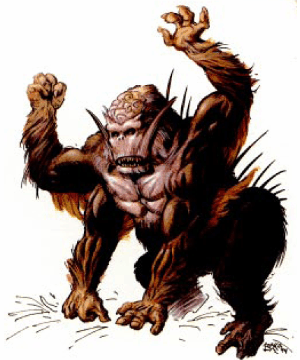

MC Dark Sun Appendix II (Terrors beyond Tyr)

| Climate/Terrain: | Forests |
|---|---|
| Frequency: | Rare |
| Organization: | Clan |
| Activity Cycle: | Day |
| Diet: | Omnivore |
| Intelligence: | Very (11-12) |
| Treasure: | Nil |
| Alignment: | Neutral evil |
| No. Appearing: | 1-4 (1d4) |
| Armor Class: | 4 |
| Movement: | 9 |
| Hit Dice: | 7+1 |
| THAC0: | 13 |
| No. of Attacks: | 5 |
| Damage/Attack: | 1d6+1(×4)/2d4+1 |
| Special Attacks: | Grab and pummel |
| Special Defenses: | Nil |
| Magic Resistance: | Nil |
| Size: | L (8’) |
| Morale: | Elite (14-16) |
| XP Value: | 2,000 |
Psionics Summary
| Level | Dis/Sci/Dev | Attack/Defense | Score | PSPs |
|---|---|---|---|---|
| 7 | 3/4/12 | EW,II,MT,PB/IF,MB,MBk,TW | 13 | 50 |
Psychometabolism – Sciences: death field, shadow form; Devotions: adrenaline control, cell adjustment, chameleon power, displacement.
Psychoportation – Sciences: nil; Devotions: blink, post-hypnotic suggestion.
Telepathy – Sciences: psionic blast, domination; Devotions: ego whip, id insinuation, inflict pain, invisibility, plant mind, mind thrust.
Feylaars are large, lumbering four-armed, apelike creatures known for their physical strength. Once hunted for slave labor, feylaars quickly demonstrated that their psionic powers made them too dangerous to domesticate.
Feylaars stand nearly a foot taller than most elves and possess the breadth to match. Four powerful arms stretch from the torso, each able to act independently of the other three. Though the creatures are capable of standing fully erect, feylaars usually move about on their legs and lower arms. Inside the feylaars’ large mouths are two sets of fangs, one upper and one lower, and many sharp teeth that enable them to quickly grind and swallow flesh. When surprised, feylaars’ thick, course hair is a dull gray or black, but usually the beasts use their psionics to blend with the environment.
Combat: The feylaar’s first tactic in battle is to conceal itself from its target, hoping to initiate a surprise attack. Its psionic powers and natural affinity for hiding give a +2 to the feylaar’s surprise roll.
Once upon its foe, the feylaar begins a relentless battery of blows from its mighty fists, and bites from its massive jaws. Each punch from a fist inflicts 2-7 points of damage, followed by a bite that inflicts 2-9 points of damage. If two or more fists successfully hit in a round, the feylaar grabs the target. This grabs allows the feylaar to position its victim carefully and deliver a two-handed crush to both sides of the head, inflicting 2-20 (2d10) points of damage.
A held individual can take no action requiring free arms or hands. However, each subsequent round the victim can attempt to break free by making a successful Strength roll with a -4 penalty to the individual.s effective Strength.
During combat, the feylaar uses psionics to avoid damage. The creature stops its regular attacks to make a life draining touch if its hit points are particularly low.
Habitat/Society: Though feylaars assemble into general clans, their strongest tie comes from mating. A male and female bond for life, sharing a loyalty, tenuous at best, with the remainder of the clan. Every two to three years, the female gives birth, following a nine-month gestation period. Both parents help rear the infant until it reaches its adult stage, eight years later. A typical feylaar lives as long as 45 years, though females tend to have slightly shorter life spans because of the stress of childbearing.
Ecology: The origin of the feylaar is shrouded in mystery. Though their discovery is recent, their population density, especially in the Forest Ridge west of the Ringing Mountains, indicates they have existed on Athas for some time. Rumors say that a long-dead sorcerer king created the feylaar to swell the ranks of his army with soldiers that could fight without weapons. Another story suggests that the feylaars themselves wrought their second pair of arms via their psychometabolism. Such legends are ill-founded at best, but offer as much insight as any hidden truth.
Feylaars loathe captivity. They are impossible to hold for long. They can generate a death field that often takes many handlers and feeders to the grave with them.
